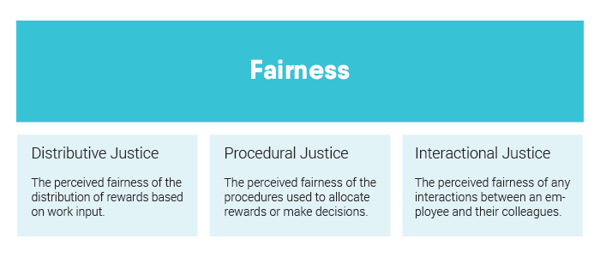Fairness is widely studied within academic literature, where it is known as Organisational Justice. However, it is not commonly measured within organisations themselves. Perhaps because organisations don't fully understand its importance and relationship to business outcomes.
In the literature, Organisational Justice is defined as “the extent to which employees perceive workplace procedures, interactions, and outcomes to be fair in nature” (Baldwin, 2004). It is typically broken down into three factors:

- Distributive Justice – the perceived fairness of the distribution of rewards based on work input. It is important to note that employees perceive fairness by comparing their rewards to that of someone who is similar to them, e.g. a co-worker. Injustices are perceived when employees feel their co-workers (who have similar input and experience) are receiving greater rewards or recognition than they are.
- Procedural Justice – the perceived fairness of the procedures used to allocate rewards or make decisions. For example, whether performance reviews are conducted by someone who the employee has frequent contact with. Or whether employees are given the opportunity to challenge any appraisal decisions.
- Interactional Justice – the perceived fairness of any interactions between an employee and their colleagues, but mainly their supervisor. I.e. Whether an employee thinks they are being treated fairly by their supervisor.
Measuring fairness
If you are looking to measure fairness, you could focus on questions that represent these three injustices:
Distributive Justice
‘Compared to my co-workers, I am fairly rewarded and recognised for the work that I do’.
Procedural Justice
‘The procedures used to allocate rewards and make decisions are fair’.
Interactional Justice
‘I am treated fairly by my supervisor’.
Why is it important that we measure these injustices?
It is important that employees perceive that they are being treated fairly through processes like performance appraisals, disciplinary procedures, conflict resolution, layoffs and terminations, selection and staffing, and organisational change.
Perceived fairness drives positive outcomes such as increased organisational commitment, increased organisational citizenship behaviours, increased job satisfaction, and good health and wellbeing.
On the other hand, the perception of unfairness or injustice can lead to negative outcomes such as turnover, theft, vandalism, intentional idleness, absenteeism, employee fraud, exit behaviours, withdrawal behaviours, and grievance filing.
So, treat your employees fairly or suffer the wrath of perceived injustice!
How does an organisation manage fairness?
Preventive and retrospective methods are both useful. For example, a revision of the procedures used to delegate rewards and make decisions can help prevent any perceived injustice altogether.
What’s also useful is providing employees with the means to access support when injustice is perceived. Make it known what they should do and who they should go to if they feel they have been treated unfairly.
Lastly, having a voice is crucial because it can serve as both a preventative and remedial means of promoting justice. Enabling employees to have an opinion, and the ability to challenge or change decisions, will go a long way in ensuring that fairness is universally perceived.
Check out Fairness in the Workplace for a more detailed review of the fairness and organisational justice literature.

